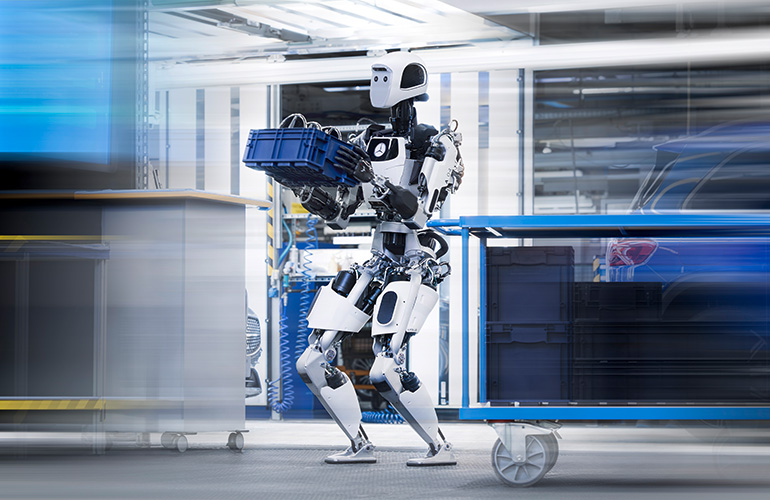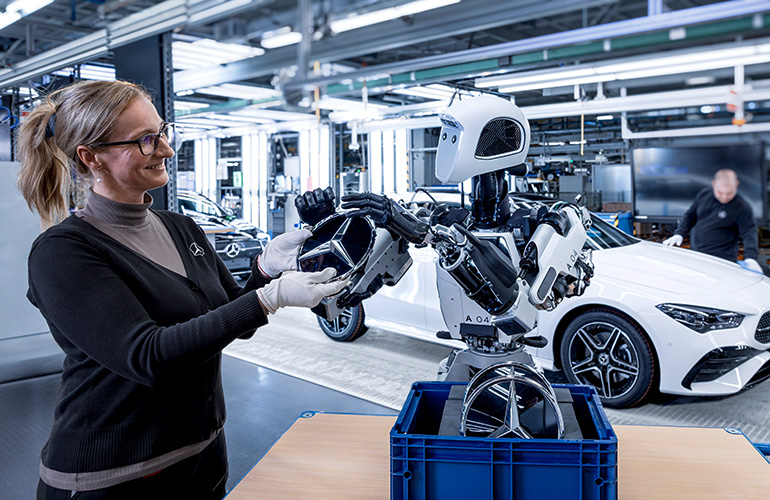|
Listen to this article |

Apollo moving a tote at the Mercedes factory. | Credit: Apptronik
Apptronik today announced that leading automotive brand Mercedes-Benz is testing its Apollo humanoid robot. As part of the agreement, Apptronik and Mercedes-Benz will collaborate on identifying applications for Apollo in automotive settings.
Mercedes-Benz is exploring how well Apollo can bring parts to the production line for workers to assemble, while simultaneously inspecting the components. Apollo will also be tested at delivering totes of kitted parts later in the manufacturing process.
“When we set out to build Apollo, an agreement like the one we’re announcing today with Mercedes-Benz was a dream scenario,” Jeff Cardenas, co-founder & CEO of Apptronik, said in a press statement. “Mercedes plans to use robotics and Apollo for automating some low-skill, physically challenging, manual labor – a model use case which we’ll see other organizations replicate in the months and years to come.”
The Robot Report reached out to both Apptronik and Mercedes to learn more, but hadn’t heard back at press time. At the moment, it is unclear how many Apollos are being tested, if multiple automotive plants are involved, and what the extent of this partnership is. The photos Apptronik shared show Apollo in a plant in Hungary.
Humanoid race heats up
Apptronik unveiled Apollo in August 2023 and is one of the early innovators in the humanoid race, joining the likes of Agility Robotics’ Digit and Tesla Optimus. Since August, additional manufacturers have thrown their collective hats in the humanoid ring, including 1X, Figure AI, Sanctuary AI, Unitree, LimX and Fourier Intelligence.
The robotics market is at a unique point in time where all of the enabling technologies that make a humanoid viable are coming together. This includes the huge leaps in AI maturity and model training over the last two years, the power of edge compute, battery capacity, and the maturation of legged motion algorithms.
But there are at least two big looming questions: “What can humanoids reliably do?” and “Does it make sense for robots to be on legs versus wheels?” A key milestone for these humanoid manufacturers is to pass these early tests and secure reference customers that validate the robot’s functionality and help guide the product roadmap.

Apollo can autonomously navigate the factory floor and avoid obstacles. | Credit: Apptronik
Automotive manufacturing is the leading adopter of robotics worldwide. Automotive manufacturers are under pressure to improve quality, and reduce costs, all while struggling to deal with labor issues. It makes perfect sense that the automotive market would explore how humanoids could help. Optimus will be tested at internal Tesla manufacturing plants, Figure has an agreement with BMW, and Agility Robotics has landed pilots with Amazon and GXO Logistics.
Why humanoids? Why now?
Back to the question of “Why humanoids?” Apptronik said the addition of humanoids to factories and plants would allow organizations like Mercedes-Benz to deploy robotics that are optimized to perform in spaces that are designed for humans, thus avoiding full-scale facility redesigns that are built around robots rather than people. In short, this approach centers on automating some physically demanding, repetitive, and dull tasks for which it is increasingly hard to find reliable workers.
Apollo, which has a form factor that roughly matches the size of a human worker (5 feet 8 inches tall and 160 lb with the ability to lift 55 lb), is built to operate in industrial spaces. Combined with a unique force control architecture that maintains safe operation around people (similar to a collaborative robot versus a traditional industrial robot), Apollo’s design allows it to work alongside people while simultaneously taking on physically demanding tasks, Apptronik said.

Apollo can safely work side by side and collaboratively with humans on the production line. | Credit: Apptronik
“To build the most desirable cars, we continually evolve the future of automotive production. Advancements in robotics and AI open up new opportunities for us. We are exploring new possibilities with the use of robotics to support our skilled workforce in manufacturing,” said Jörg Burzer, member of the board of management of Mercedes-Benz Group AG, production, quality & supply chain management. “This is a new frontier, and we want to understand the potential both for robotics and automotive manufacturing to fill labor gaps in areas such as low skill, repetitive and physically demanding work and to free up our highly skilled team members on the line to build the world’s most desirable cars.”
Jonathan Hurst, co-founder and chief robot officer of Agility Robotics, will keynote the Robotics Summit & Expo, which runs May 1-2 in Boston. The event expects more than 5,000 attendees and is designed to help robotics engineers overcome the technical challenges of building commercial robots. The Robotics Summit & Expo is produced by The Robot Report and parent company WTWH Media.
Hurst’s keynote on May 1 from 9:00 to 9:45 a.m. ET is titled “Humanoid Robots Get to Work.” It will explore the technological breakthroughs propelling humanoids like Digit into real-world use cases. Attendees will learn about the ongoing challenges and opportunities and will go inside Digit’s first pilots.





